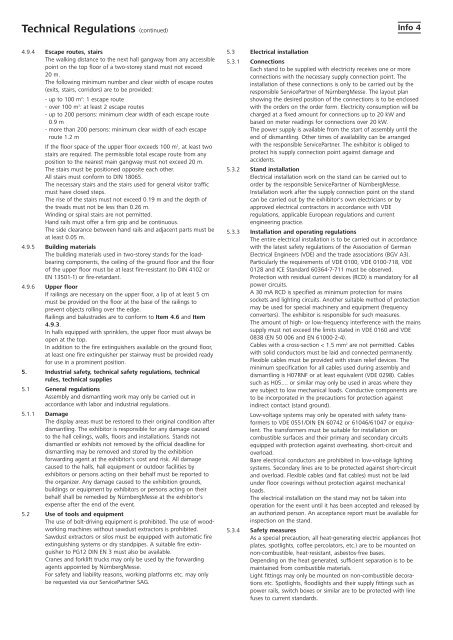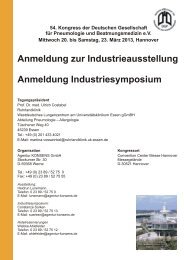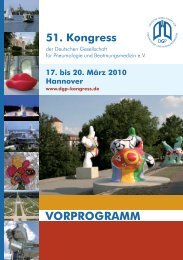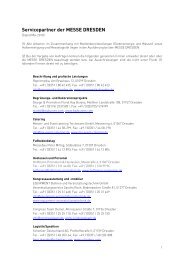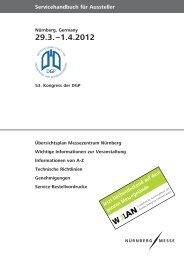Instruction Sheet - Agentur KONSENS
Instruction Sheet - Agentur KONSENS
Instruction Sheet - Agentur KONSENS
You also want an ePaper? Increase the reach of your titles
YUMPU automatically turns print PDFs into web optimized ePapers that Google loves.
16<br />
16<br />
Technical Regulations (continued)<br />
4.9.4 Escape routes, stairs<br />
The walking distance to the next hall gangway from any accessible<br />
point on the top floor of a two-storey stand must not exceed<br />
20 m.<br />
The following minimum number and clear width of escape routes<br />
(exits, stairs, corridors) are to be provided:<br />
- up to 100 m2 : 1 escape route<br />
- over 100 m2 : at least 2 escape routes<br />
- up to 200 persons: minimum clear width of each escape route<br />
0.9 m<br />
- more than 200 persons: minimum clear width of each escape<br />
route 1.2 m<br />
If the floor space of the upper floor exceeds 100 m2 , at least two<br />
stairs are required. The permissible total escape route from any<br />
position to the nearest main gangway must not exceed 20 m.<br />
The stairs must be positioned opposite each other.<br />
All stairs must conform to DIN 18065.<br />
The necessary stairs and the stairs used for general visitor traffic<br />
must have closed steps.<br />
The rise of the stairs must not exceed 0.19 m and the depth of<br />
the treads must not be less than 0.26 m.<br />
Winding or spiral stairs are not permitted.<br />
Hand rails must offer a firm grip and be continuous.<br />
The side clearance between hand rails and adjacent parts must be<br />
at least 0.05 m.<br />
4.9.5 Building materials<br />
The building materials used in two-storey stands for the loadbearing<br />
components, the ceiling of the ground floor and the floor<br />
of the upper floor must be at least fire-resistant (to DIN 4102 or<br />
EN 13501-1) or fire-retardant.<br />
4.9.6 Upper floor<br />
If railings are necessary on the upper floor, a lip of at least 5 cm<br />
must be provided on the floor at the base of the railings to<br />
prevent objects rolling over the edge.<br />
Railings and balustrades are to conform to Item 4.6 and Item<br />
4.9.3.<br />
In halls equipped with sprinklers, the upper floor must always be<br />
open at the top.<br />
In addition to the fire extinguishers available on the ground floor,<br />
at least one fire extinguisher per stairway must be provided ready<br />
for use in a prominent position.<br />
5. Industrial safety, technical safety regulations, technical<br />
rules, technical supplies<br />
5.1 General regulations<br />
Assembly and dismantling work may only be carried out in<br />
accordance with labor and industrial regulations.<br />
5.1.1 Damage<br />
The display areas must be restored to their original condition after<br />
dismantling. The exhibitor is responsible for any damage caused<br />
to the hall ceilings, walls, floors and installations. Stands not<br />
dismantled or exhibits not removed by the official deadline for<br />
dismantling may be removed and stored by the exhibition<br />
forwarding agent at the exhibitor's cost and risk. All damage<br />
caused to the halls, hall equipment or outdoor facilities by<br />
exhibitors or persons acting on their behalf must be reported to<br />
the organizer. Any damage caused to the exhibition grounds,<br />
buildings or equipment by exhibitors or persons acting on their<br />
behalf shall be remedied by NürnbergMesse at the exhibitor's<br />
expense after the end of the event.<br />
5.2 Use of tools and equipment<br />
The use of bolt-driving equipment is prohibited. The use of woodworking<br />
machines without sawdust extractors is prohibited.<br />
Sawdust extractors or silos must be equipped with automatic fire<br />
extinguishing systems or dry standpipes. A suitable fire extinguisher<br />
to PG12 DIN EN 3 must also be available.<br />
Cranes and forklift trucks may only be used by the forwarding<br />
agents appointed by NürnbergMesse.<br />
For safety and liability reasons, working platforms etc. may only<br />
be requested via our ServicePartner SAG.<br />
Info 4<br />
5.3 Electrical installation<br />
5.3.1 Connections<br />
Each stand to be supplied with electricity receives one or more<br />
connections with the necessary supply connection point. The<br />
installation of these connections is only to be carried out by the<br />
responsible ServicePartner of NürnbergMesse. The layout plan<br />
showing the desired position of the connections is to be enclosed<br />
with the orders on the order form. Electricity consumption will be<br />
charged at a fixed amount for connections up to 20 kW and<br />
based on meter readings for connections over 20 kW.<br />
The power supply is available from the start of assembly until the<br />
end of dismantling. Other times of availability can be arranged<br />
with the responsible ServicePartner. The exhibitor is obliged to<br />
protect his supply connection point against damage and<br />
accidents.<br />
5.3.2 Stand installation<br />
Electrical installation work on the stand can be carried out to<br />
order by the responsible ServicePartner of NürnbergMesse.<br />
Installation work after the supply connection point on the stand<br />
can be carried out by the exhibitor's own electricians or by<br />
approved electrical contractors in accordance with VDE<br />
regulations, applicable European regulations and current<br />
engineering practice.<br />
5.3.3 Installation and operating regulations<br />
The entire electrical installation is to be carried out in accordance<br />
with the latest safety regulations of the Association of German<br />
Electrical Engineers (VDE) and the trade associations (BGV A3).<br />
Particularly the requirements of VDE 0100, VDE 0100-718, VDE<br />
0128 and ICE Standard 60364-7-711 must be observed.<br />
Protection with residual current devices (RCD) is mandatory for all<br />
power circuits.<br />
A 30 mA RCD is specified as minimum protection for mains<br />
sockets and lighting circuits. Another suitable method of protection<br />
may be used for special machinery and equipment (frequency<br />
converters). The exhibitor is responsible for such measures.<br />
The amount of high- or low-frequency interference with the mains<br />
supply must not exceed the limits stated in VDE 0160 and VDE<br />
0838 (EN 50 006 and EN 61000-2-4).<br />
Cables with a cross-section < 1.5 mm2 are not permitted. Cables<br />
with solid conductors must be laid and connected permanently.<br />
Flexible cables must be provided with strain relief devices. The<br />
minimum specification for all cables used during assembly and<br />
dismantling is H07RNF or at least equivalent (VDE 0298). Cables<br />
such as H05.... or similar may only be used in areas where they<br />
are subject to low mechanical loads. Conductive components are<br />
to be incorporated in the precautions for protection against<br />
indirect contact (stand ground).<br />
Low-voltage systems may only be operated with safety transformers<br />
to VDE 0551/DIN EN 60742 or 61046/61047 or equivalent.<br />
The transformers must be suitable for installation on<br />
combustible surfaces and their primary and secondary circuits<br />
equipped with protection against overheating, short-circuit and<br />
overload.<br />
Bare electrical conductors are prohibited in low-voltage lighting<br />
systems. Secondary lines are to be protected against short-circuit<br />
and overload. Flexible cables (and flat cables) must not be laid<br />
under floor coverings without protection against mechanical<br />
loads.<br />
The electrical installation on the stand may not be taken into<br />
operation for the event until it has been accepted and released by<br />
an authorized person. An acceptance report must be available for<br />
inspection on the stand.<br />
5.3.4 Safety measures<br />
As a special precaution, all heat-generating electric appliances (hot<br />
plates, spotlights, coffee percolators, etc.) are to be mounted on<br />
non-combustible, heat-resistant, asbestos-free bases.<br />
Depending on the heat generated, sufficient separation is to be<br />
maintained from combustible materials.<br />
Light fittings may only be mounted on non-combustible decorations<br />
etc. Spotlights, floodlights and their supply fittings such as<br />
power rails, switch boxes or similar are to be protected with line<br />
fuses to current standards.


